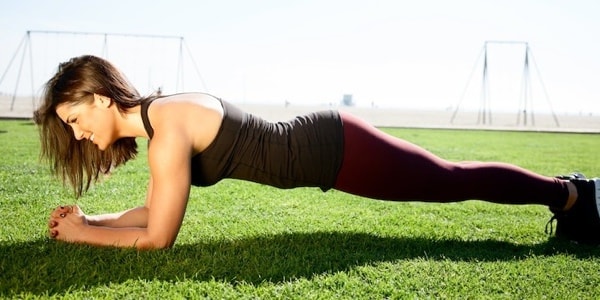The plank (also called a front hold, hover, or abdominal bridge) is an isometric core strength exercise that involves maintaining a difficult position for extended periods of time. The most common plank is the front plank which is held in a push-up position with the body's weight borne on forearms, elbows, and toes.
Many variations exist such as the side plank and the reverse plank. The plank is commonly practiced in pilates and yoga, and by those training for boxing and other sports.
The plank strengthens the abdominals, back, and shoulders. Muscles involved in the front plank include:
- Primary muscles: erector spinae, rectus abdominis (abs), and transverse abdominus.
- Secondary muscles (synergists/segmental stabilizers): trapezius (traps), rhomboids, rotator cuff, the anterior, medial, and posterior deltoid muscles (delts), pectorals (pecs), serratus anterior, gluteus maximus (glutes), quadriceps (quads), and gastrocnemius.
Muscles involved in the side plank include:
- Primary: transversus abdominis muscle, gluteus medius and gluteus minimus muscles (abductors), the adductor muscles of the hip, and the external, and internal obliques.
- Secondary: gluteus maximus (glutes), quadriceps (quads), and hamstrings.
How to do a plank

Get into pushup position on the floor. Now bend your elbows 90 degrees and rest your weight on your forearms. Your elbows should be directly beneath your shoulders, and your body should form a straight line from your head to your feet. Hold the position for as long as you can. Your goal should be to hold it for two minutes.
Ways to improve your plank time. The longer you can hold the plank, the more resilient your lower back will be to injury, and the better your abs will look once you burn the fat off them. Follow these tips for longer plank times.
Practice: Perform planks several times each day, trying to hold the position a little longer each time. Use body-weight exercises: Pushups and pullups will improve your core strength.
Squat and deadlift: Guys who are strong in these specific lifts find planks are no problem.
Hold it. If you don't have the core strength yet to do a regular plank, you can build up to it by doing a bent-knee plank. If you can hold a plank for more than two minutes with ease, you can move on to these tougher variations.
Lift one leg up. By simply raising one leg in the air, you dramatically increase the demand on your core to fight your body's natural urge to rotate.
Lift one arm up. Again, your body will want to fall to one side. Don't let it!
Use a Swiss ball. Rest your forearms on the ball and you'll have to stabilize your body and stop the ball from rolling out from under you.